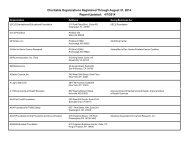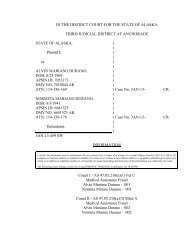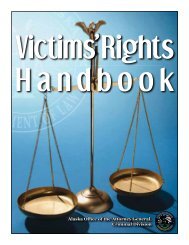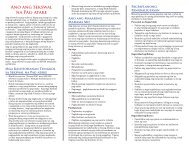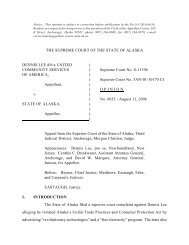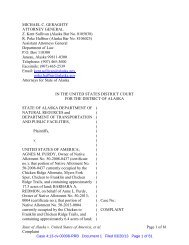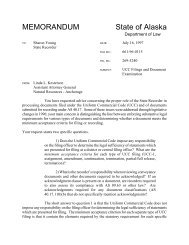Initial Report and Recommendations - Alaska Department of Law
Initial Report and Recommendations - Alaska Department of Law
Initial Report and Recommendations - Alaska Department of Law
- No tags were found...
You also want an ePaper? Increase the reach of your titles
YUMPU automatically turns print PDFs into web optimized ePapers that Google loves.
9. Adequate legal infrastructure to h<strong>and</strong>le cases & adequate infrastructure to provideservices.10. Who would investigate reports <strong>of</strong> harm?11. Authority for the State to place <strong>and</strong> reimburse foster parents for children in triballylicensed foster homes <strong>and</strong> attendant liability issues.12. Guardians ad litem.(Further material on the discussions <strong>of</strong> these details can be found in the Work Group materials)Impact Statement:This would give State representatives <strong>and</strong> Tribal representatives the opportunity to build on thesubcommittee’s work, <strong>and</strong> craft a State/Tribal ICWA agreement that might take into account thechanges in the law since 1990 <strong>and</strong> reduce the number <strong>of</strong> issues over which the State <strong>and</strong> Tribesare currently litigating.______________________________________________________________________________Recommendation 5 (JS-6): Tribal Court Referrals <strong>of</strong> Juveniles to State Division <strong>of</strong> JuvenileJusticeStatement <strong>of</strong> Need:In particular cases there may be a need for traditional <strong>Alaska</strong> Native village justice systems todraw more effectively upon state juvenile agencies.Option:Urge the Division <strong>of</strong> Juvenile Justice to make agreements with Tribes <strong>and</strong> tribal courts tocoordinate the disposition <strong>of</strong> juvenile <strong>of</strong>fenses as currently permitted under state law.Rationale for Option:• Currently, tribal courts <strong>and</strong> councils <strong>of</strong>ten work with juveniles <strong>and</strong> their parents in response tothe child’s delinquent or troublesome behavior in the village. Such proceedings do notusually come to the attention <strong>of</strong> state authorities, <strong>and</strong> some village justice systems prefer thisoutcome because it keeps their minors from acquiring juvenile records within the state courtsystem.• Other Village justice systems, however, would prefer to coordinate more closely with DJJ inscreening <strong>and</strong> disposition <strong>of</strong> juvenile <strong>of</strong>fenders. Specifically some village justice systemsmight wish to refer a juvenile to DJJ, with the consent <strong>of</strong> DJJ. This option urges DJJ todiscuss with interested tribal councils whether such a referral mechanism might be achieved.Impact Statement:Better coordination among tribal <strong>and</strong> state juvenile justice systems.______________________________________________________________________________Recommendation 6 (D-DS 10)Statement <strong>of</strong> problem:Not all victims & communities have access to immediate safety.Current Status:a) 21 domestic violence/sexual assault programs listed with Council on Domestic Violence <strong>and</strong>Sexual Assault (CDVSA) Community Outreach.b) These programs serve all <strong>of</strong> rural <strong>Alaska</strong> but resources <strong>and</strong> geography inhibit ideal safety in therural areas.Ideal Status:Each community has a safety plan to address victim <strong>and</strong> community safety.Structural Barriers (e.g., statutes, regulations, etc.):No single local organizing entity is identified to facilitate community development;no single point <strong>of</strong> contact for safety issues.<strong>Alaska</strong> Rural Justice <strong>and</strong> <strong>Law</strong> Enforcement Commission - Page 83



